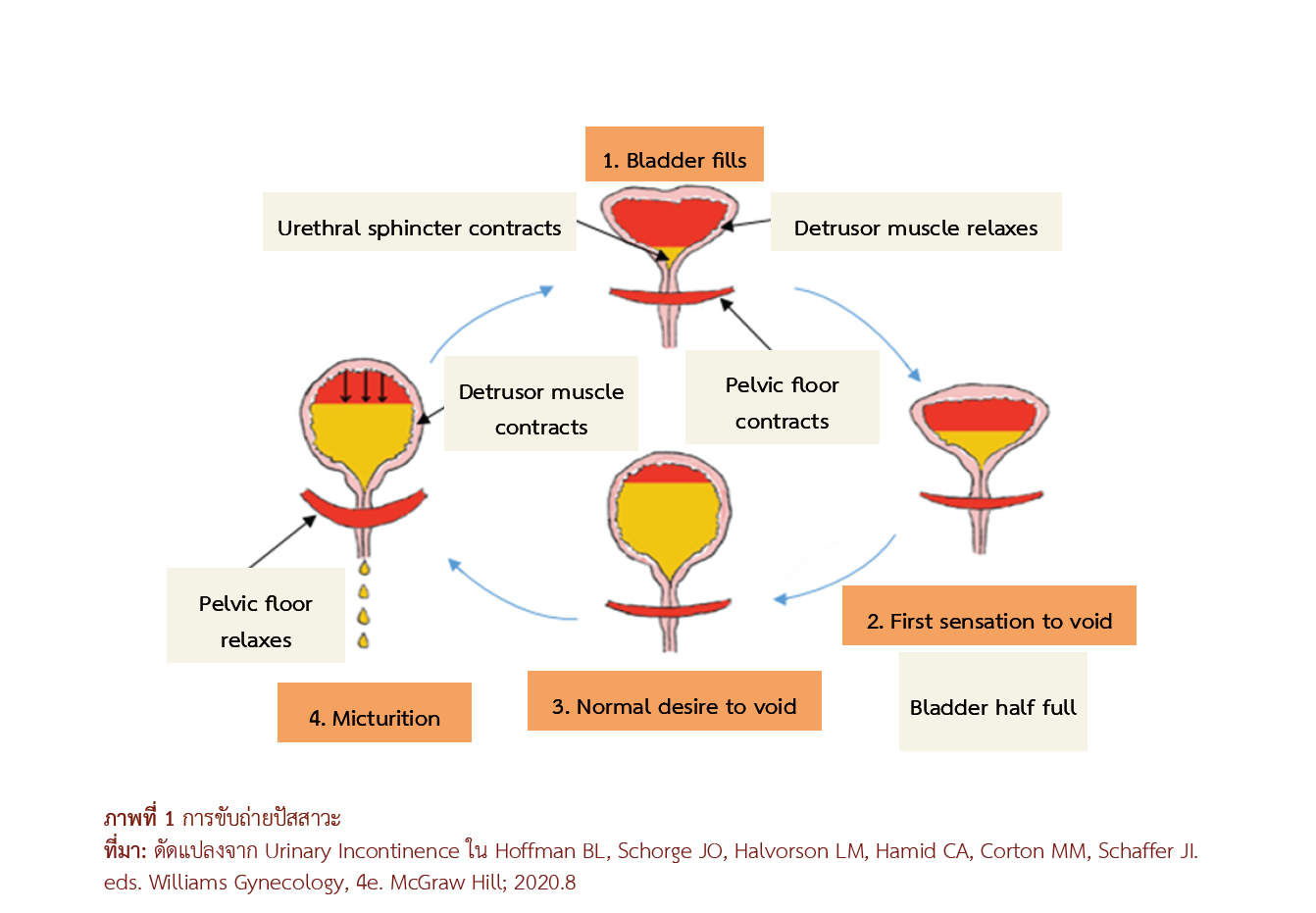Nursing Care for Urinary Incontinence in Elderly
Main Article Content
Abstract
Urinary incontinence is the involuntary leakage of urine which is considered a serious health issue in the elderly. Major contributing factor is physiological decline. Urinary incontinence can become chronic and affect the physical, psychological, social, and economic conditions of the elderly. It can have a negative impact on quality of life in a variety of ways such as skin irritation from urine exposure which can cause rashes and infection; sleep deprivation; and psychological issues such as lack of self-confidence, embarrassment, depression, and eventually social avoidance. Information from comprehensive assessment of the elderly can be used to solve the problems, cure them, and prevent complications. This article aims to equip nurses with the knowledge and understanding needed to provide holistic care, advice patients with urinary incontinence and their families, systematically implement health promotion and disease prevention, and optimize environment and other factors affecting quality of life of the elderly in order to help the elderly engage in social activity and adapt to their physiological changes with comfort.
Article Details

This work is licensed under a Creative Commons Attribution-NonCommercial-NoDerivatives 4.0 International License.
References
สถาบันเวชศาสตร์สมเด็จพระสังฆราชญาณสังวรเพื่อผู้สูงอายุ กรมการแพทย์ กระทรวงสาธารณสุข. แนวทางเวชปฏิบัติการดูแลผู้สูงอายุที่มีภาวะกลั้นปัสสาวะไม่อยู่ [อินเตอร์เน็ต]. 2564 [เข้าถึงเมื่อ 4 สิงหาคม 65]. เข้าถึงได้จาก: https://www.tuanet.org/
ชัชวาล วงค์สารี. โรคไตและระบบทางเดินปัสสาวะ. กรุงเทพฯ: N P Press Limited Partnership, 2559.
ปนิฏฐา นาคช่วย. บทความฟื้นวิชา ภาวะกลั้นปัสสาวะไม่อยู่ในผู้สูงอายุ Urinary Incontinence in Elderly. เวชสารแพทย์ทหารบก [อินเทอร์เน็ต]. 2559;69(1):39-44. เข้าถึงได้จาก https://he02.tci-thaijo.org/index.php/rtamedj/article/view/65521/53559
คัทรียา รัตนวิมล. บทความวิชาการ การพยาบาลผู้สูงอายุที่มีปัญหากลั้นปัสสาวะไม่อยู่ Nursing Care in Urinary Incontinence Problem Among the Elderly. วารสารพยาบาลศาสตร์ มหาวิทยาลัยนเรศวร [อินเทอร์เน็ต]. 2552;3(2):1-12. เข้าถึงได้จาก http://www.nurse.nu.ac.th/Journal/data/Vol.3%20No.2/001.pdf
International Continence Society. Standardisation [Internet]. 2002 [cited 2022 Apr 23]. Available from: https://www.icsoffice.org
Pizzol D, Demurtas J, Celotto S, et al. Urinary incontinence and quality of life: a systematic review and meta-analysis. Aging Clin Exp Res 2021;33:25–35.
มุทิตา จองวรรณศิริ, วิทย์ วิเศษสินธุ์. การพยาบาลผู้ป่วยกระเพาะปัสสาวะพิการจากการบาดเจ็บไขสันหลังที่รับการตรวจยูโรพลศาสตร์. Rama Nurs J [อินเทอร์เนต]. 2562;25(3):270-271. เข้าถึงได้จาก https://med.mahidol.ac.th/nursing/jns/DocumentLink/D_100604.pdf.
Hoffman BL, Schorge JO, Halvorson LM, Hamid CA, Corton MM, Schaffer JI. eds. Williams Gynecology, 4e. McGraw Hill; 2020.
Castronovono, A. D. Urinary incontinence assessment in older adults. The Hartford institude for geriatric nursing, New York University, College of Nursing [Internet]. 2007. Available from: https://www.anzsgm. Org/vgmtp/Continence/About%20this.
Cook K., Sobeski L.M. Urinary Incontinence in the Older Adult: PSAP, 2013.
นพ.วันทิน ศรีเบญจลักษณ์, รศ.พญ.ปณิตา ลิมปะวัฒนะ. ภาวะกลั้นปัสสาวะไม่อยู่ในผู้สูงอายุ. วารสารประสาทวิทยาศาสตร์ ภาคตะวันออกเฉียงเหนือ [อินเทอร์เนต]. 2556;8:2-92. เข้าถึงได้จาก https://he01.tci-thaijo.org/index.php/bcnsp/article/download/239987/164435/
ฐานา ธรรมคุณ, กาญจนา แก้วอ้น, จิราภา แซ่แต้. การเสริมสร้างพลังอำนาจในการควบคุมการปัสสาวะและส่งเสริมภาวะจิตสังคมในผู้ป่วยกลั้นปัสสาวะไม่อยู่. พุทธชินราชเวชสาร [อินเทอร์เนต]. 2552;2:133-41. เข้าถึงได้จาก https://he01.tci-thaijo.org/index.php/jdpc7kk/article/download/162153/116955/449242
จิรวรรณ อินคุ้ม. การกลั้นปัสสาวะไม่อยู่ในผู้สูงอายุ. วารสารการแพทย์และวิทยาศาสตร์สุขภาพ [อินเทอร์เนต]. 2558;1:58-68. เข้าถึงได้จาก https://he01.tci-thaijo.org/index.php/bcnsp/article/view/239987
เรไร มงคลพันธ์. ผลของการบริหารกล้ามเนื้ออุ้งเชิงกรานต่อการป้องกันภาวการณ์กลั้นปัสสาวะไม่อยู่ในผู้หญิง. [วิทยานิพนธ์ปริญญาพยาบาลศาสตรมหาบัณฑิต]. กรุงเทพฯ: มหาวิทยาลัยคริสเตียน; 2550.
พุทธิพร พิธานธนานุกูล พย.ม. ภาวะกลั้นปัสสาวะไม่อยู่ในผู้สูงอายุ. วารสารวิทยาศาสตร์สุขภาพ วิทยาลัยพยาบาลบรมราชชนนี สรรพสิทธิประสงค์ 2563;4:19-36.
Thirugnanasothy S. Managing urinary incontinence in older people. BMJ 2010;341:339-43.
Sampselle, C.M. Behavioral Intervention for Urinary Incontinence in Women: Evidence for Practice. Journal of Midwifery & Women’s Health, 2000;45(2):94-102.
นพ.ฉันท์หทัย นันท์หทัย, อ.พญ.ศศิวิมล ศรีสุขโข. Bladder test, make if simple for Bernal gynecologist. [Internet].2561 [เข้าถึงเมื่อ 2565 พฤษภาคม 6]. เข้าถึงได้จาก https://w1.med.cmu.ac.th/obgyn/
Balk EM, Rofeberg VN, Adam GP, Kimmel HJ, Trikalinos TA, Jeppson PC. Pharmacologic and Nonpharmacologic Treatments for Urinary Incontinence in Women: A Systematic Review and Network Meta-analysis of Clinical Outcomes. Ann Intern Med. 2019 Apr 2;170(7):465-479.
Tsai YH, Liu CH. The effectiveness of pelvic floor exercises, digital vaginal palpation and interpersonal support on stress urinary incontinence: An experimental study. Ijnurstu. 2014;46(9):1181-6.
NewmanDK. Pelvic floor muscle rehabilitation using biofeedback. Urologic nursing. 2014;34(4):193-202.
Ghoniem GM, Van Leeuwen JS, Elser DM, Freeman RM, Zhao YD, Yalcin I, Bump RC; Duloxetine/Pelvic Floor Muscle Training Clinical Trial Group. A randomized controlled trial of duloxetine alone, pelvic floor muscle training alone, combined treatment and no active treatment in women with stress urinary incontinence. J Urol. 2005 May;173(5):1647-53.
Lightner DJ, Gomelsky A, Souter L, Vasavada SP. Diagnosis and Treatment of Overactive Bladder (Non-Neurogenic) in Adults: AUA/SUFU Guideline Amendment 2019. J Urol. 2019;202(3):558-63.
Frank C, Szlanta A. Office Management of Urinary Incontinence Among Older Patients. Can Fam Physician 2010;56:1115-20.
Cardozo L. Urinary Incontinence in Women: Have We Anything New to Offer? BMJ 1991;303:1453-7.
Newman, D.K., Ee, C.H., Gordon, D. et al. Continence promotion, education & primary prevention. In: P., Abrams, L., Cardozo, S., Khoury, A., Wein, eds. Incontinence, Proceedings from the 4th International Consultation on Incontinence. Plymouth, UK: Health Publication 2009:1643– 1684.
World Health Organization. Integrated care for older people guidelines (ICOPE) about Evidence profile: urinary incontinence. Geneva: Switzerland. [Internet]. 2017. Available from: https://apps.who.int/iris/bitstream/handle/10665/341989/WHO-MCA-17.06.10-eng.pdf






